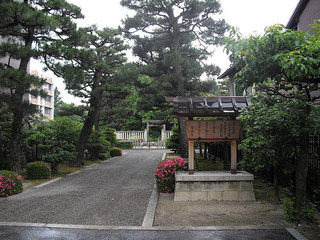Difference between revisions of "Emperor Go-Nijo"
m (→References) |
(link) |
||
| Line 5: | Line 5: | ||
*''Japanese'': 後二条天皇 ''(go-nijou tennou)'' | *''Japanese'': 後二条天皇 ''(go-nijou tennou)'' | ||
| − | Go-Nijô was an [[emperor]] of the [[Kamakura period]]. He was the eldest son of [[Emperor Go-Uda]] and [[Minamoto no Kishi]] (also known as Saikamon'in), but did not succeed his father directly. Due to a custom of the time of alternating the throne between two Imperial lineages, following Go-Uda's retirement in [[1287]], [[Emperor Fushimi|Emperors Fushimi]] and [[Emperor Go-Fushimi|Go-Fushimi]] of the Jimyôin line ruled, before the throne returned to the Daikaku-ji line. Go-Nijô thus took the throne in [[1301]], while Go-Uda continued to rule as [[insei|retired emperor]]. | + | Go-Nijô was an [[emperor]] of the [[Kamakura period]]. He was the eldest son of [[Emperor Go-Uda]] and [[Minamoto no Kishi]] (also known as Saikamon'in), but did not succeed his father directly. Due to a custom of the time of alternating the throne between [[Daikakuji and Jimyoin lines|two Imperial lineages]], following Go-Uda's retirement in [[1287]], [[Emperor Fushimi|Emperors Fushimi]] and [[Emperor Go-Fushimi|Go-Fushimi]] of the Jimyôin line ruled, before the throne returned to the Daikaku-ji line. Go-Nijô thus took the throne in [[1301]], while Go-Uda continued to rule as [[insei|retired emperor]]. |
The Daikaku-ji line fractured during Go-Nijô's reign, as two, and then three, separate claimants to the succession emerged. Go-Nijô then died in [[1308]], at age 23, and was succeeded by [[Emperor Hanazono]]. | The Daikaku-ji line fractured during Go-Nijô's reign, as two, and then three, separate claimants to the succession emerged. Go-Nijô then died in [[1308]], at age 23, and was succeeded by [[Emperor Hanazono]]. | ||
Latest revision as of 09:20, 2 September 2013
Go-Nijô was an emperor of the Kamakura period. He was the eldest son of Emperor Go-Uda and Minamoto no Kishi (also known as Saikamon'in), but did not succeed his father directly. Due to a custom of the time of alternating the throne between two Imperial lineages, following Go-Uda's retirement in 1287, Emperors Fushimi and Go-Fushimi of the Jimyôin line ruled, before the throne returned to the Daikaku-ji line. Go-Nijô thus took the throne in 1301, while Go-Uda continued to rule as retired emperor.
The Daikaku-ji line fractured during Go-Nijô's reign, as two, and then three, separate claimants to the succession emerged. Go-Nijô then died in 1308, at age 23, and was succeeded by Emperor Hanazono.
Go-Nijô is buried at Kitashirakawa-no-misasagi in northeastern Kyoto.
| Preceded by Emperor Go-Fushimi |
Emperor of Japan 1301-1308 |
Succeeded by Emperor Hanazono |
References
- "Go-Nijô Tennô." Nihon jinmei daijiten 日本人名大辞典. Kodansha, 2009.
